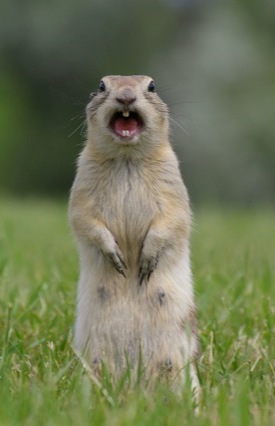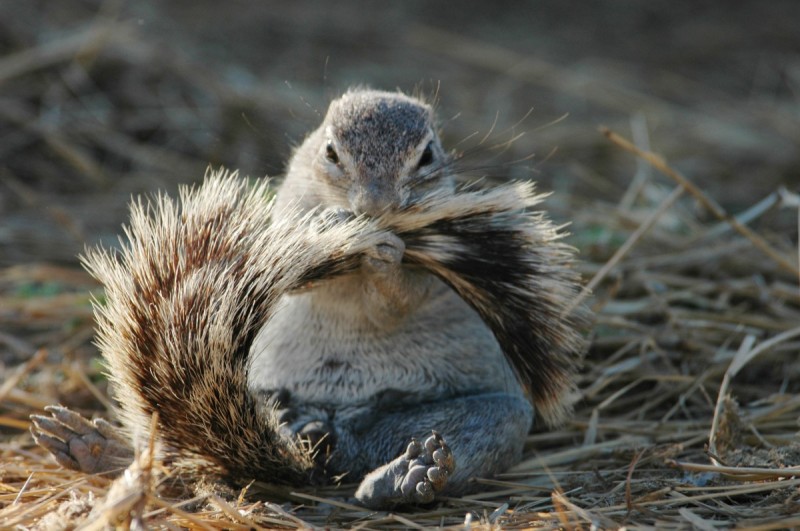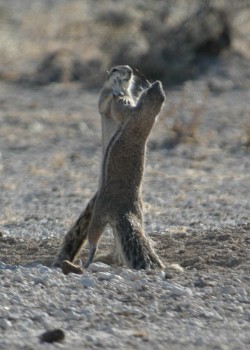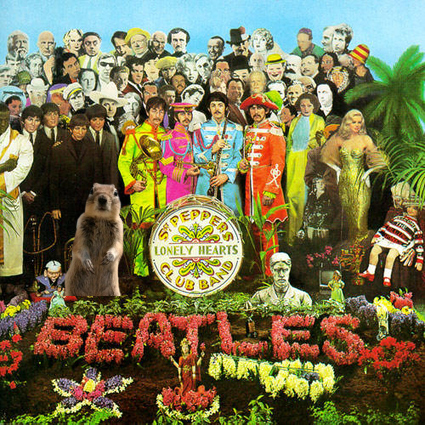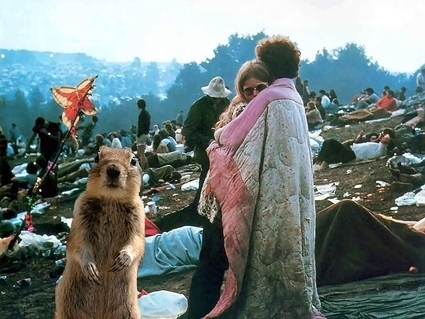
A Barbary ground squirrel from the Canary Islands // Photo: Jane Waterman
Finally, a day just for squirrels
Since January 21, 2014, was Squirrel Appreciation Day, UM Today wants celebrate these marvelous mammals by sharing some research and stories about them gathered by University of Manitoba biologists.
We recently reported on the findings of James Hare, biological sciences, wherein he explains the jump-yip displays performed by black-tailed prairie dogs, a member of the squirrel family. The findings show an animal with a remarkable level of communication and conscious awareness.
Professor Hare has been investigating the communication techniques and displays of these animals for decades and each study seems to uncover new levels of sophistication.
“Richardson’s ground squirrels recognize alarm callers as individuals, an ability that not only allows them to enumerate the number of individuals calling, and to track the movement of predators within their colony, but also to weight their response to individual callers according to how reliable they’ve been in the past,” Hare says.
“Quite the intellectual prowess for animals we often take for granted!”
In 2004, Hare and his colleague David Wilson made a surprising report in Nature on Richardson ground squirrels, a species native to the prairies including the Winnipeg area: they use ultrasonic communication to warn others of predators, demonstrating the first known ultrasonic alarm call.
” To our knowledge,” they wrote, “ultrasonic alarm calls have not previously been detected in any animal group, despite their twin advantages of being highly directional and inaudible to key predators.”
Interestingly, the study notes that audible calls evoked a more pronounced response than these “whisper calls” (called such because when you see a squirrel perform one, its body assumes the position of a regular call except only the faint sound of air can be heard coming from its mouth). Hare and Wilson think this suggests that whisper calls either convey less urgency, or that respondents react less conspicuously to them.
Why study squirrels?
“Squirrels are intriguing because they deal with a very harsh environment and a lot of predators. Indeed, they’ve developed, or evolved, a variety of different strategies for coping with these challenges in life,” Hare says. “Many become social, some of them are hibernators – dropping their metabolic rate right down. So there are all sorts of ways they cope with these challenges. And the fact of the matter is they are just a convenient studies species: they’re mammals and yet they are small and they’re abundant. They’re everywhere around us and they make a living in disturbed environments that humans have moved into and modified. Squirrels are survivors.”
Professor Jane Waterman, also in biological sciences, studies squirrels as well. She studies four species of ground squirrels — one in Winnipeg, one in the Canary Islands and two in southern Africa. Writing about the Cape Ground Squirrel for BBC magazine, she aims to shift the way we think about these animals.
The females
“When you think of a squirrel,” she writes, “you probably picture a solitary tree climber. You might not automatically envisage an animal that lives in burrows and is as sociable as lions or dolphins. Yet the Cape ground squirrel Xerus inauris of southern Africa relies on living in close-knit groups to survive. Ranging throughout the dry regions of Botswana, Namibia and the Republic of South Africa, this burrowing rodent is perhaps best known for using its tail to provide vital shade to beat the heat of this harsh environment, hence its nickname ‘parasol-tailed squirrel.’”
She goes on: “Relying on powerful forepaws as digging tools, the Cape ground squirrel prefers areas of compact soil, which allow it to construct durable, complex burrow systems. Within these burrows, the squirrel lives in two distinct social groups: the first contains related females and their offspring; the second comprises bands of unrelated adult males.
“Female groups contain up to three adult females and up to nine young. Females give birth at any time of year and the periods when the females are receptive to mating are irregular and unpredictable. Though litters are small – just one or two young at a time – females can breed four times a year.
“The females leave their groups to give birth alone but return when their young are on the verge of weaning. The entire group then helps care for the growing youngsters including grooming them and watching out for predators – the young being particularly vulnerable to the many large snakes that inhabit the region. It soon becomes virtually impossible to distinguish which young squirrels belong to which mother.”
The males
“Young males disperse away from their natal burrow and join an all-male gang,” Waterman writes for the BBC. “These male groups contain up to 19 individuals but, unlike the cohesive female groups, males form smaller sub-bands, changing members daily. There is no evidence of co-operative defence or territoriality and, similar to female groups, these all-male bands show minimal signs of aggression. The key to dominance is age not body size or fighting ability as is often the case with other mammals.
“The older the squirrel, the more elevated his position in the male hierarchy. Occasionally, however, young adult males delay dispersal, sometimes remaining with the females for years after they have reached sexual maturity. Finally, even these reluctant males must disperse, usually because they’ve been kicked out of the group. And just like males that disperse at an earlier age, they join up with a band of unrelated males.”
Closer to home, the on-going squirrel war
In Canada, a turf war is being fought between two competing species of squirrel; Hare describes it here in this 2010 interview recorded by the U of M. If pre-fight bets were made, most money would have backed the eastern grey squirrel, a 600- to 700-gram creature that has been moving west across Canada and out competing the North American red squirrels, measly 350-gram contenders.
Typically, when grey squirrels establish themselves in an area, they displace the red squirrels (a problem Britain has only recently reported success in). But, this is not happening in Winnipeg. As Hare notes, there is no systematic study investigating why this is the case here in Manitoba. But the fact remains, “ounce-for-ounce, red squirrels are much more ferocious than grey squirrels,” Hare says.
Yet the grey squirrel has an advantage in terms of body size and body size is perhaps one of the most universal predictors of an animal’s competitive ability, Hare notes. Indeed, many contests between competitors won’t escalate to a fight if one competitor is much smaller — why would it risk injury and expend the energy on a probable loss?
“Red squirrels haven’t read the textbook on [this],” Hare says. In central Canada, the red squirrels are undaunted: when a grey squirrel intrudes on its territory “it goes after them with a vengeance.” They will physically charge the grey squirrel, even though the grey squirrels is roughly twice its size. They will scream and bite and persist until they drive the grey squirrel out.
Why don’t the grey squirrels fight back? “I don’t know,” Hare says. “And frankly I don’t think anyone else knows either.” For more on this battle, listen to Hare in this interview.
For the academic in you
Here are some PDFs of squirrel studies conducted by Professor Hare:
- A short one-page summary for the journal Nature on the whisper calls of ground squirrels
- A study in Current Zoology about, to be glib, Richardson ground squirrels listen to their mother no better than friends
- A study on the squirrels’ “Neighbourhood Watch” program, published in Animal Behaviour
- A study on the information encoded in a warning call, published in ScienceDirect.
Error thrown
Object of class WP_Error could not be converted to string







